FY2022 Annual Report
Quantum Dynamics Unit
Professor Denis Konstantinov
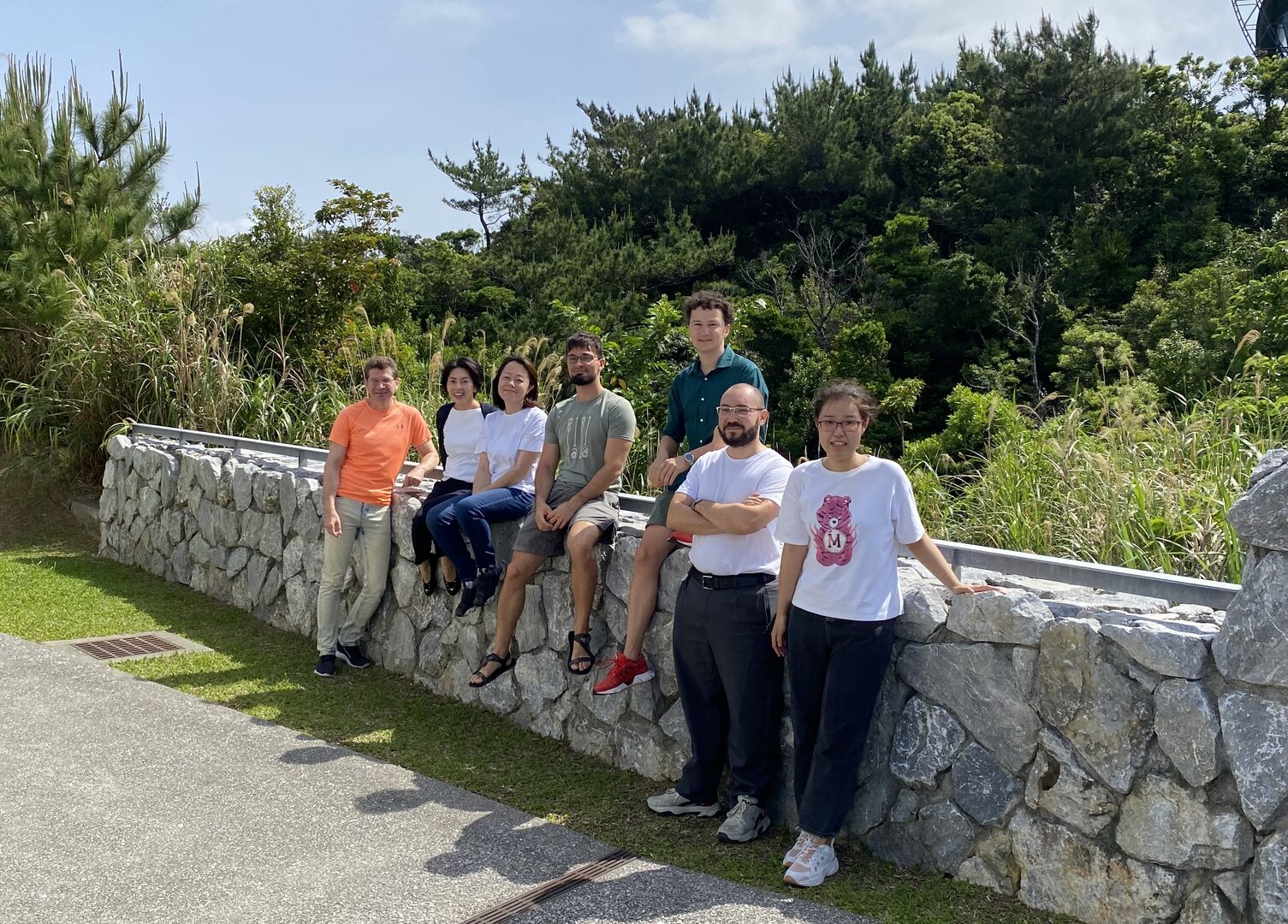
Left to right: Denis Konstantinov, Taki Tazuke, Jui-Yin Lin, Ivan Kostylev, Kirill Shulga, Mikhail Belianchikov, Wanting He
Abstract
In FY2022, we have almost entire concentarted our efforst towards realizing qubits for quantum computing using electron spins on the surface of liquid helum. We finalized our theoretical proposal for a blueprint of scalable quantum computer using spins of individually trapped electrons on superfluid helium (link). We expect that this proposal will shape up our experiemental activities for the next several years. We have also started intensive experiemental efforts towards the quantum Rydberg state detection of a single trapped electrons, which is the first most essential step towards realizing the spin detection and building spin qubits.
In FY2022 we said farwell to Dr. Shan Zou who sucessully defended her PhD in August 2022 and joined Intel in China. We also said farwell to Dr. Mohamed Hatifi, who moved as a postoc to the Quantum Machines Unit in OIST, and welcomed two new memebrs, Dr. Jui-Yin Lin (our former PhD student) and Dr. Wanting He, who jointed our group as new postdocs.
1. Staff
- Dr. Ivan Kostylev, Postdoctoral Scholar
- Dr. Mohamed Hatifi, Postdoctoral Scholar
- Dr. Kirill Shulga, Postdoctoral Scholar
- Dr. Mikhail Belianchikov, Postdoctoral Scholar
- Dr. Tomoyuki Tani, Postdoctoral Scholar
- Dr. Jui-Yin Lin, Postdoctoral Scholar
- Dr. Wanting He, Postdoctoral Scholar
- Shan Zou, Graduate Student
- Jakob Kraus, Intern Student
- Taki Tazuke, Research Unit Administrator
2. Collaborations
2.1 Proposal for a scalable quantum computer using electron spins on superfluid helium
- Description: We constructed a theoretical blueprint for quantum computer which uses spins of many-electron system trapped on the surface of liquid helium.
- Type of collaboration: Joint research
- Researchers:
- Dr. Erika Kawakami, Hakubi Team Leader, Center for Quantum Cimputing, RIKEN
- Dr. Monica Benito, Institute of Quantum Technologies, German Aerospace Center (DLR)
- Dr. Jiabao Chen, QunaSys Inc., Tokyo
2.2 Cryogneic tunable microwave generator based on a tunnel-diode oscillator
- Description: We develop a tunable cryogenic microwave generator operating in the frequency range ~0.1 GHz for quantum computing applications.
- Type of collaboration: Joint research
- Researchers:
- Dr. Erika Kawakami, Hakubi Team Leader, Center for Quantum Cimputing, RIKEN
- Prof. Tomohiro Otsuka, Quantum Devices Group, AIMR, Tohoku University
2.3 Quantum Rydberg state detection of electrons trapped on solid neon
- Description: We attempt to setup an experiment to detect the Rydberg transtion in the system of electrons trapped on the surface of solid neon in the 2-3~THz frequency range.
- Type of collaboration: Joint research
- Researchers:
- Dr. Hideki Hirayama, Chief Scientists, Quantum Optodevice Laboratory, RIKEN
3. Activities and Findings
3.1 Blueprint for a scalable quantum computer using electron spins on superfluid helium (D. Konstantinov in collboration with E. Kawakami (RIKEN), Monica Benito (German Aerospace Center) and J. Chen (Qunasys Inc.)).
We finalized our theoretical proposal and constructed a complete blueprint of a scalable quantum computer using spins of elecrons trapped on the surface of superfluit helium (link). In our proposal, individual electrons are trapped in the electrostatic potential created by a quantum-dot-like electrode structures (see Fig. 1(a)). The orbital (Rydberg states) and spin degrees of freedom are coupeld by a stray magnetic field gradiant created by a magnetized trap electrode (see Fig. 2(b,c)), while quantum state readout is acomplished by a resonant RF circuit (see bottom of Fig. 1(a)). Two individual spins are coupled together by means of the spin-orbit inetercation and Coulomb interaction bewteen electrons (see Fig. 1(d)).
We estiameted the single-qubit gate fidelity of 99.9999% and two-qubit gate fidelity of 99%. We also estimate that the single-spin readout in a measurement bandwidth of ~1 MHz is feasible using a resonant RF circuit.
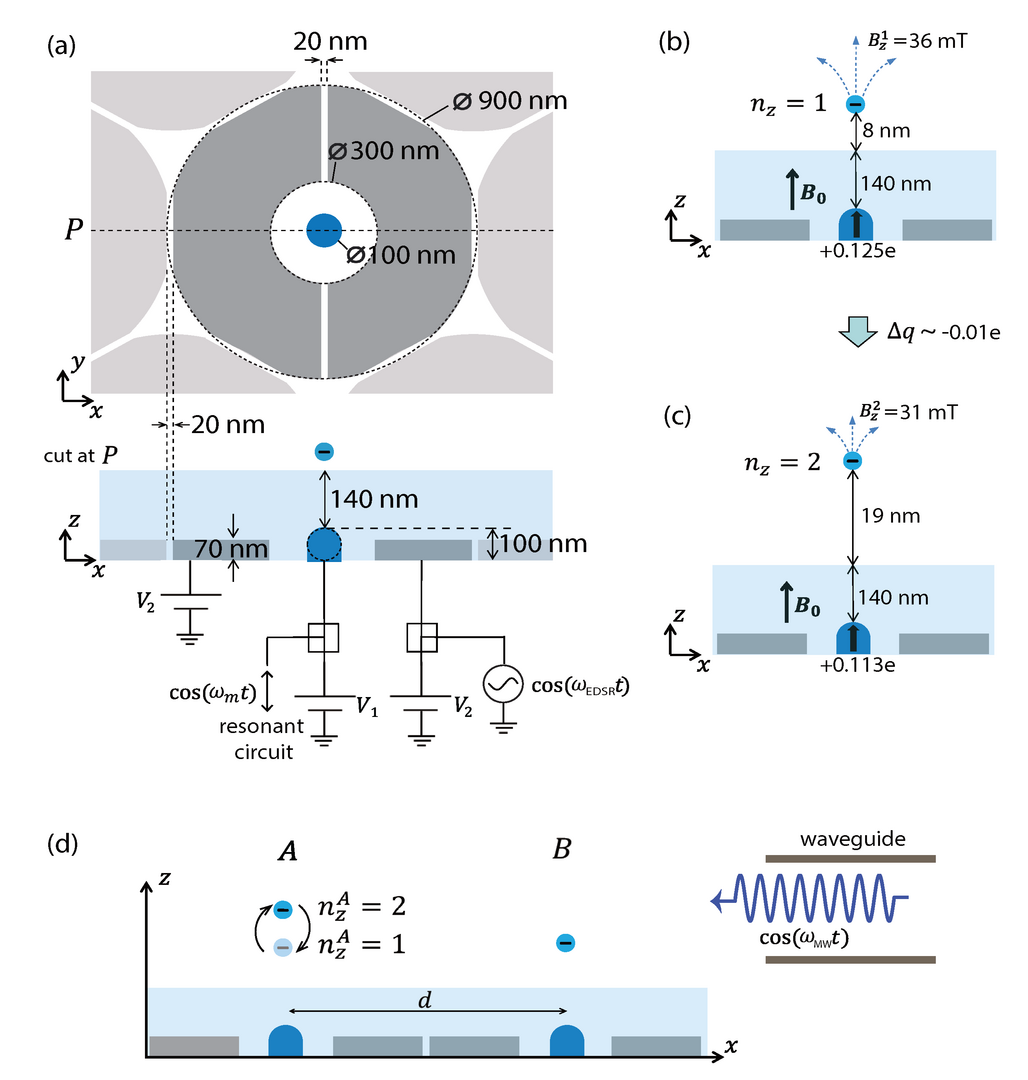
Figure 1: A blueprint for scalable quantum computer using electron spins trapped on the surface of superfluid helium.
3.2 Quantum Rydberg state detecton of electrons confined in a single μm-size channel (M. Belianchikov and S. Zoe).
We detected the Rydberg transtion of electrons confined in a single 10μm-wide and 4μm-deep channel filled with superfliud He4 using a superconducting resonant tank circuit (see FY2021 Annual report). The electrons are tuned in resonance via the Stark shift by varying the channel electrode voltage. By decreasing the number of electrons trapped in the channel, we observed a gradual shift of the broad Rydberg resonance (see traces in Fig. 2, from right to left), until a very sharp transtion peak emerges at about 1.1 V. The width of this transition peak corresponds to about 70 MHz, from which we estimate that the signal is comming from about 100 electrons. This significantly improves the detection sensitivity of our previous setup (see FY2021 Annual report).
Our nearest set goal is to detect the transition coming from a single electron, which requires further optimization of the detection circuit and reduction of noise. A sucessul detection of the Rydberg transtion of a single electron will acomplish the first most important step towards realization of the proposed blueprint for the scalable quantum computer using electrons on superfluid helium.

Figure 2: Rydberg transition in electrons confined in a single microchannel detected by a resonant superconducting tank circuit.
3.3 Development of a cryogenic low-noise amplifier for the quantum Rydberg state detection (M. Belianchikov and J. Kraus).
In order to improve the Rydberg transition detection by the image-charge method, we constructed and tested a new cryogenic low-noise amplifier. It is based on the High-Electron Mobility Transistor (HEMT) which allows us to operate it at a very small dissipating power ~1 μW at the temperature ~100 mK of the mixing chamber of a dilution refrigerator. The electric circuit and the photograph of the constructed amplifier are shown in Fig. 3 (a,b). The amplifier has a high input impedance required for image-current measurements using a high-impedance superconducting tank circuit (see FY2021 Annual report) and 50-Ohm matched output impedance compatible with a commercially awailable second-stage amplifier.
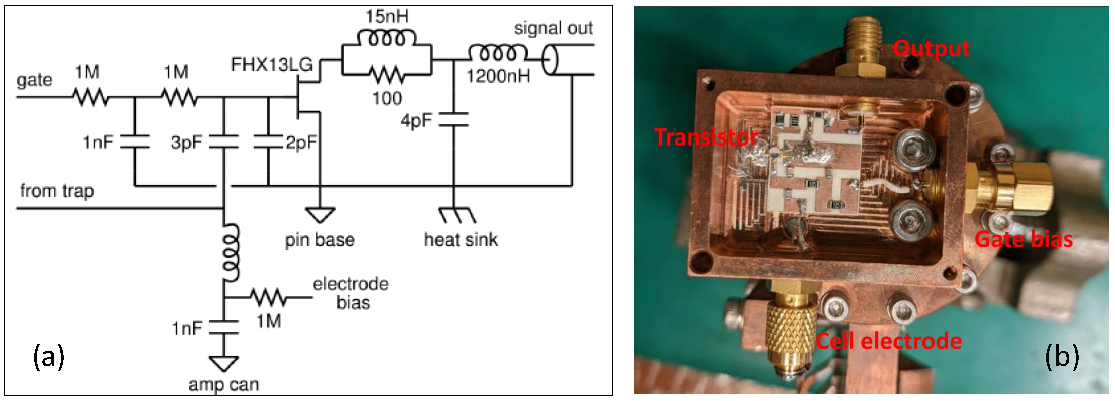
Figure 3: Electric circuit (a) and photograph (b) of a home-made cryogenic low-noise HEMT amplifier for the image-charge detector of the Rydberg transition in electrons liquid helium.
3.4 Observation of some unexpected transtion resoanances in electrons on liquid helium (M. Belianchikov, I. Kostylev and J. Kraus).
Using the experimental setup with a superconducting resonant tank circuit and the cryogenic low-noise HEMT amplifire described above (see Fig. 4(a)), we have managed to observe a detail spectrum of the Rydberg transitions in electrons on superfluid He4 shown in Fig. 4(b). In addition to the expected transtions from the ground state to the first-excited (1-2), second-excited (1-3), third-excited (1-4) etc. Rydberg states we observed a number of "image" transtion lines having the Stark-shift slope similar to that of the 1-2 transition, see Fig. 4(b). This is the first, to the best of our knowledge, observation of such new transitions, and it became possible due to a greatly improved sensitivity of our detection setup.
Elucidation of the nature of these unexpected Rydberg transtions presents an intriguing and challenging task for FY2023.
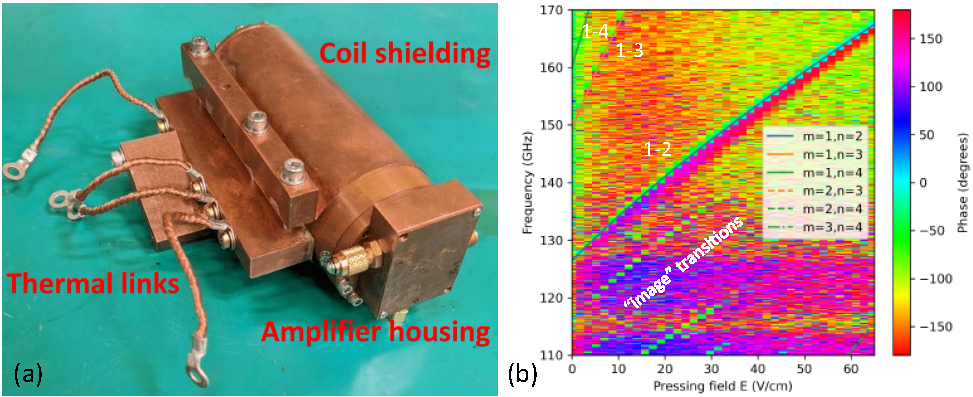
Figure 4: Image-charge detecton setup (a) and a Rydberg transiton spectrum obtained by the image-charge detection method in electrons on liquid He4 at temperature ~150 mK (b).
3.5 Development of sensitive RF reflectrometry measurements for the quantum state detection in electrons on helium (T. Tani and J.-Y. Lin).
In addition to our efforts to improve the image-charge detection method using a superconducting tank resonator we started developing a new approach for the quantum state detection based on the RF reflectometry measurements. An advatage of this method is potentially high measurement bandwidth (~1 MHz) required for a fast qubit-state readout. In this method, the quantum Rydberg transtion is detected as a small change in the capacitance incorporated into a resonant lumped-element LC circuit. The change in the capacitance is detected as a change in the spectrum of an RF signal reflected from the LC circuit at resonance.
Fig. 5 shows the photo (a) and the schematics (b) of the resonant (~70 MHz) RF circuit and the detection method. The detection circuit is mainly composed of a superconducting coil forming the inductance and a parallel-plate capacitor containing electrons on superfluid helium. Two varactors are used to (1) provide a perfect impedance matching of the LC circuit to the 50-Ohm transmission line and (2) measure the sensitivity of the capacitance-change detecton by providing the modulation of the value of the capacitance of the LC circuit. Such modulation causes appearance of the sidebands in the reflection spectrum, the amplitide of which allows to evaluate the sensitivity of the detection method.
Fig. 5 (c) shows the reflection spectrum and apperance of sidebands when a modulating ac voltage at 1 kHz is applied to the varactor Cv2 (see Fig. 5(b)). From the amplitude of the sidebands we estimate the sensitivity of the capacitance-change detection shown in Fig. 5(d) for different levels of the input RF power. Remarkably, we estimate the sensitivity of our detection circuit exceeding 0.1 aF/Hz1/2 at temperature 4.2 K.
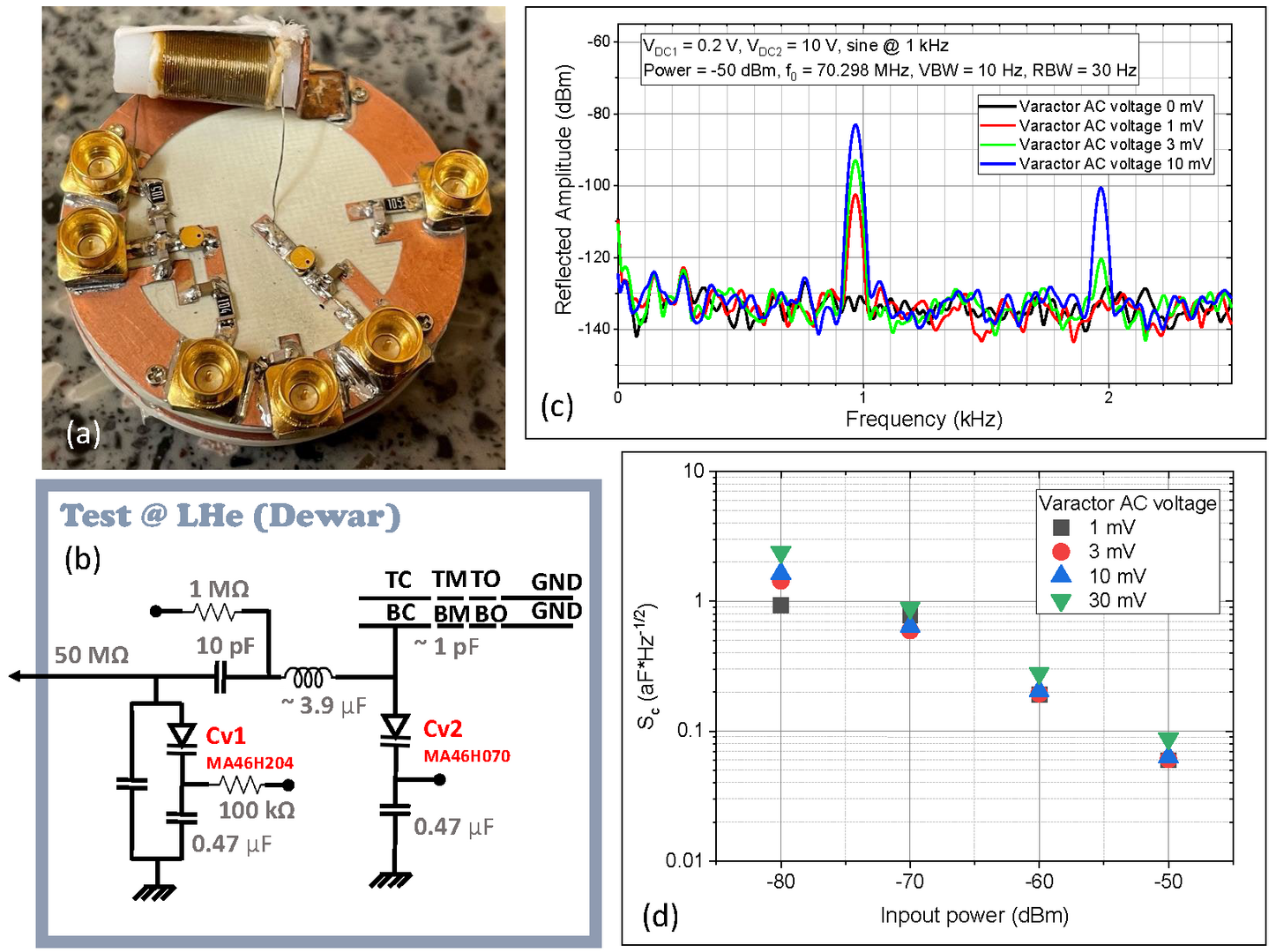
Figure 5: Photograph (a), electrical circuit (b), reflection spectrum (c) and sensitivity of the capacitance-change detection (d) for a resonant RF circuit employed in our experiments.
3.6 Detection of the Rydberg transition of electrons on bulk liquid helium using RF reflectrometry measurements (J.-Y. Lin and T. Tani).
Using the resonant RF detecton circuit described above, we have managed to sucessfully detect the Rydberg transtion of many electrons confined on the free surface of bulk lqiuid helium. The Rydberg transtition of electrons induced by the pulse-modulated microwave radiation (~140 GHz) is detected by apperance of sidebands at the modulation freqeuncy (1 kHz) in the RF reflection spectrum. Fig. 6 shows a representative spectrum obtiained from the amplitude of the sideband in the reflection spectrum. The large peak is identified as the resonant transition of electrons from the ground to the first excited Rydberg state. In addition, much weaker signals (inserted in the red squares) are obsrved and identified as "image" transtions whose origin is not known yet.
In FY2023, we paln to intesively work on the further improvement of this novel detection method and try to bring it to the detecton level of a single electron.
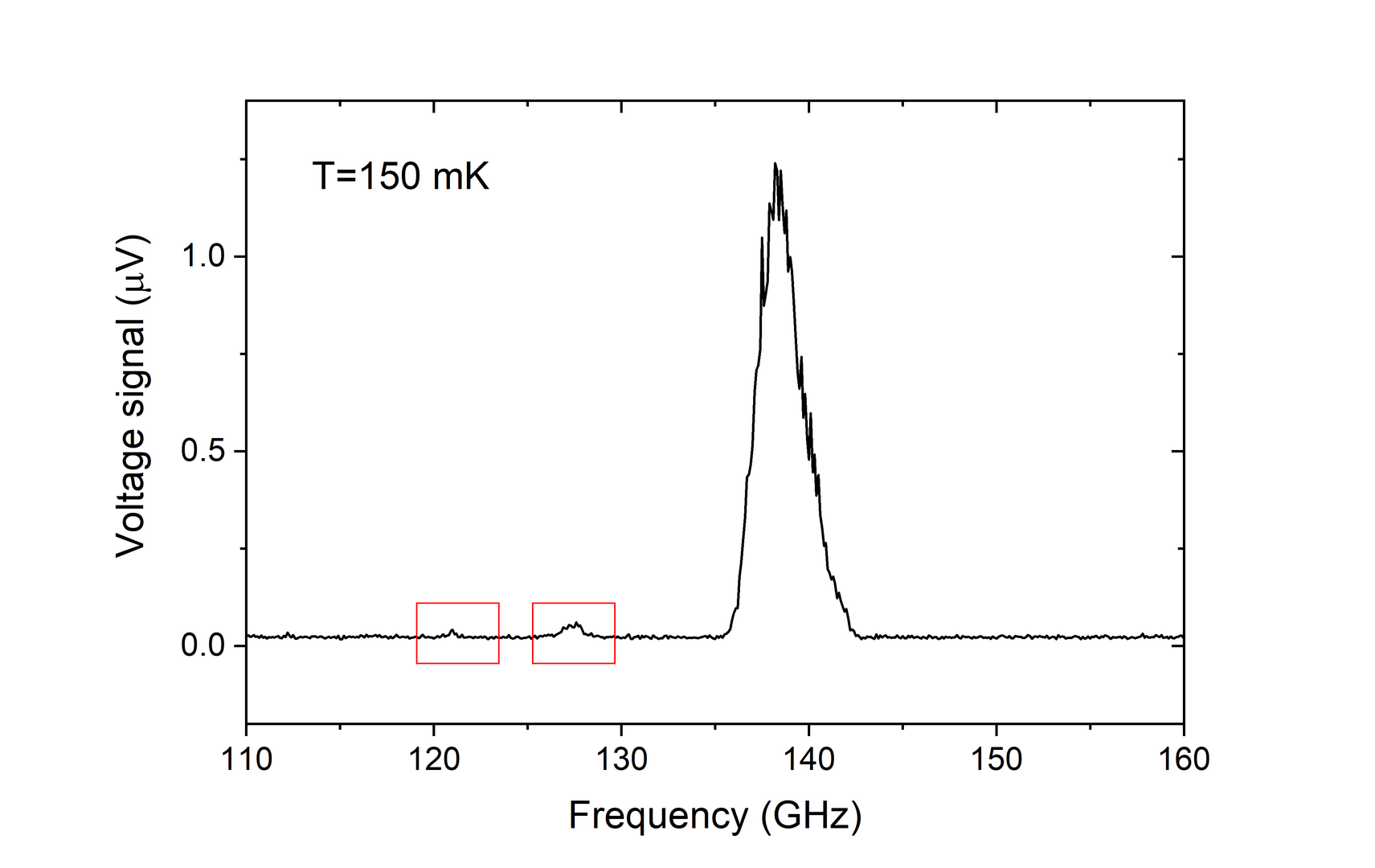
Figure 6: The Rydberg transition spectrum obtained by the novel method from the sideband amplitude in the RF reflection spectrum in responce to the pulse-modulated microwave (GHz) radiation.
3.7 Study of a novel gapless bulk magneto-plasmon mode in an electron fluid on the surface of liquid helium. (I. Kostylev).
It is generally accepted that only high-frequency magneto-plasmon modes gapped at the cyclotron frequency can propogate in the interior of a two-dimensional electron fluid. Recently (see FY2020 Annual Report) we reported an evidence for a novel bulk Gradient Magneto-Plasmon (GMP) mode observed in the surface electrons on liquid helium. In FY2022, we confirmed the excistence of this mode in an experiment were we used an electrode configuration shown in Fig. 7(a) (left). The concentric circular (Corbino) structure allowed us to probe the bulk nature of this mode, as was predicted by the numerical simulations shown in Fig. 7(a) (right), while the segmented outer elecctrode allowed us to distingush it from the localized Edge Magneto-Plasmon (EMP) mode.
We have observed both plasmon modes (see Fig. 7(b)) at the magnetic fields in the range up to 0.5 Tesla. Measurements of these modes at different driving electrode configurations confrmed the delocalized (bulk) nature of the GMP mode. We have also studied these modes for different density landscapes of the electron system to see the interplay between the bulk GMP mode and localized EMP modes which, as we speculate, have similar mechanism origanating from the classical Hall effect.
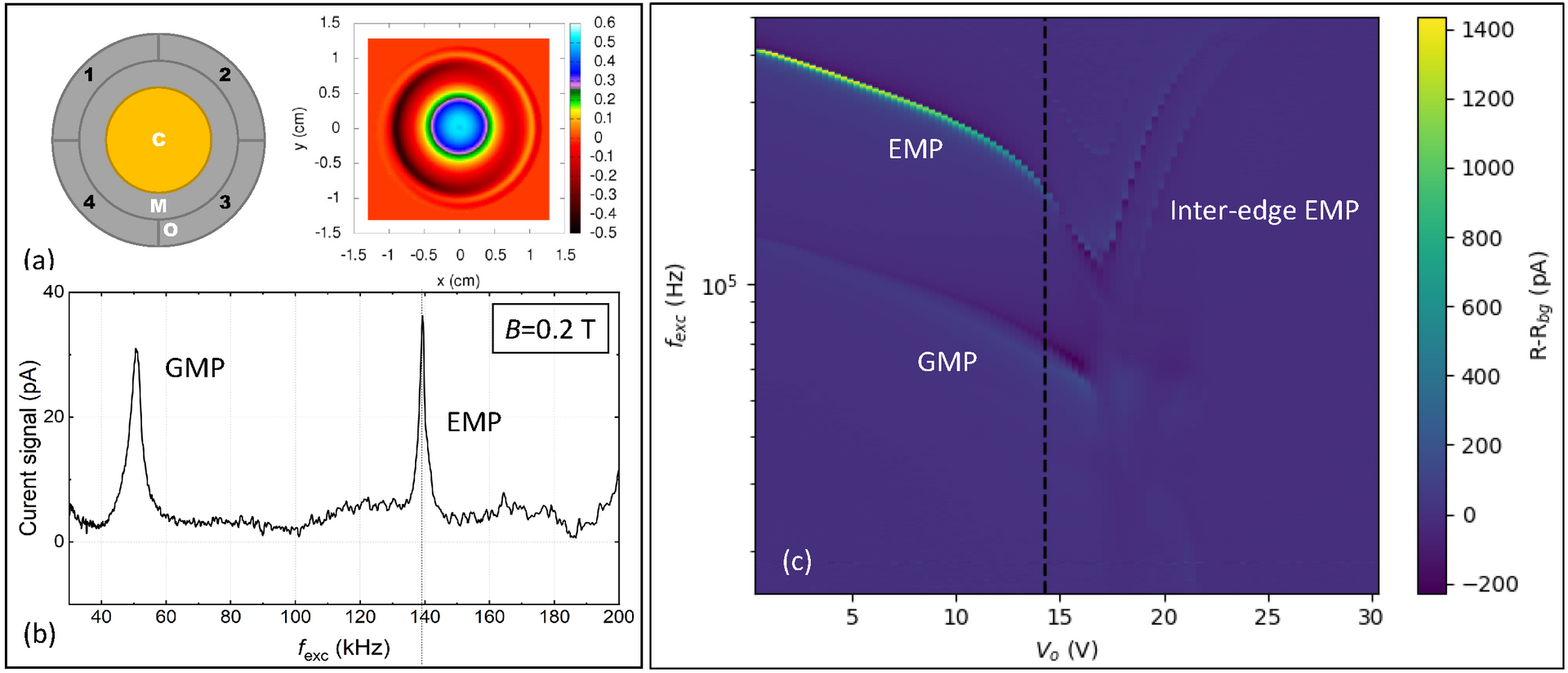
Figure 7: (a) Electrode configuration (left) and charge-oscillation distribution in the GMP mode (right). (b) Spectrum of the magneto-plasmon modes measured at the middle (M) electrode with the voltage excitation applied to the center (C) electrode. (c) Color map of magneto-plasmon spectrum measured for different DC voltages at the outer (O) electrode defining the density profile of the electron system.
4. Publications
4.1 Journals
- Zou, S., Grossenbach, S., Konstantinov, D., Observation of the Rydberg resonance in surface electrons on superfluid helium confined in a 4-mu deep channel, doi:https://doi.org/10.1007/s10909-022-02749-1 10.1177/1059712310397633 (2011).
- Hatifi, M.; Mara, D.; Bokic, B.; Van Deun, R.; Stout, B.; Lassalle, E.; Kolaric, B.; Durt, T Fluorimetry in the Strong-Coupling Regime: From a Fundamental Perspective to Engineering New Tools for Tracing and Marking Materials and Objects, doi:https://doi.org/10.3390/app12189238 (2022).
- Zou, S., Konstantinov, D., Image-charge detection of the Rydberg transition of electrons on superfluid helium confined in a microchannel structure, doi:10.1088/1367-2630/ac9696 (2022).
4.2 Books and other one-time publications
Nothing to report
4.3 Oral and Poster Presentations
- Konstantinov, D., Realization of spin qubits using electrons on superfluid helium, invited talk at the 4th Asian-Pacific Workshop on Trapped Quantum Systems (APTQS2022), Online Conference, April 21-23 (2022).
- Konstantinov, D., Realization of spin qubits using electrons on surface of superfluid helium, invited talk at the 29th International Conference on Low Temperature Physics, Supporo, Japan, August 18-24 (2022).
- Kostylev, I., Zadorozhko, A. A., Hatifi, M., Konstantinov, D., Thermoelectric Effect and Violation of Wiedemann-Franz Law for Electrons on Liquid Helium, poster presenation at the 29th International Conference on Low Temperature Physics, Supporo, Japan, August 18-24 (2022).
- Belianchikov, M., Zou, S., Konstantinov, D., Tank circuit image charge readout for electron-on-helium qubit, poster presenation at the 29th International Conference on Low Temperature Physics, Supporo, Japan, August 18-24 (2022).
- Hatifi, M., Konstantinov, D., Spin-dependent harmonic traps for electrons on liquid helium, poster presenation at the 29th International Conference on Low Temperature Physics, Supporo, Japan, August 18-24 (2022).
- Shulga, K., Konstantinov, D., Dispersive readout of the electrons on Helium Rydberg state with Landau levels, poster presenation at the 29th International Conference on Low Temperature Physics, Supporo, Japan, August 18-24 (2022).
- Yoshikawa, D., Grytsenko, I., Kato, Y., Rybalko, O., Nakao, H., Yamamoto, N., Konstantinov, D., Kawakami, E. Cryogenic tunnel-diode-oscillator for qubit read-out, poster presenation at the 29th International Conference on Low Temperature Physics, Supporo, Japan, August 18-24 (2022).
- Hatifi, M., D., Bohemian Rapsody: quantum mechanics with trajectories, OIST Internal Seminar Series, OIST, Okinawa, June 12 (2022).
- Konstantinov, D., Quantum computing with electron spins on superfluid helium, invited talk at OIST Center for Quantum Technologies Mini Symposium, OIST, Okinawa, November 09 (2022).
- Belianchikov, D., Tank circuit image charge readout for electrons on helium, poster presentaion at OIST Center for Quantum Technologies Mini-Symposium, OIST, Okinawa, November 09 (2022).
- Shulga, K., Dispersive readout of electrons on helium Rydberg states with Landau levels, poster presentaion at OIST Center for Quantum Technologies Mini-Symposium, OIST, Okinawa, November 09 (2022).
5. Intellectual Property Rights and Other Specific Achievements
Nothing to report
6. Meetings and Events
- Date: October 19, 2022
- Venue: OIST Campus Lab1, C016
- Speaker: Dr. Sergei Lemziakov (QFT Center of Excellence, Aalto University, Finland)
- Title: Experimental realization of qubit thermometry
7. Grants
-
Grant-in-Aid for Early-Career Scientists, Grant Number 20K15118: "Detection of quantum states of single electron on liquid helium" (FY2020-FY2023)
-
Grant-in-Aid for Early-Career Scientists, Grant Number 22K13985: "Dispersive readout of the electrons on helium Rydberg states with the Landau levels" (FY2022-FY2024)
- OIST Internal Grant "KICKS" for Promoting External Collaborations: "Quantum state detection of electrons on helium for qubit implemenation" (FY2022)



